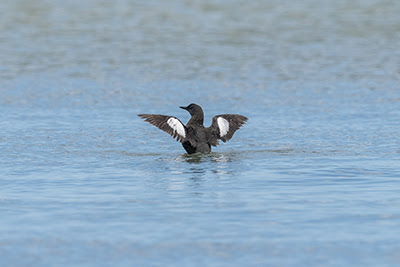Unfortunately the Wigeon didn't play ball on the rising tide so were were stood down until the tide started ebbing when it was hoped they'd haul to feed on the strand line. Back at the car park everyone had good views of a Long-tailed Duck that had flown in before deploying to check out other local sites for future reference.
Meeting up again around 10.30 this time we were in luck and after a count of 3,2,1 from Steve over the radio Rachel pushed the fire button. The result was a nice catch of Wigeon with bonus Redshank thrown in!
It was an ideal situation with the opportunity to get a close look at these gorgeous ducks and try to understand a bit more about the ageing. The males are really striking birds and there is a huge variation in the amount of green and cream on the head as show below:
Aging the males on the amount of white in the wing was fairly straight forward.
The females are another matter and the fringing on the greater and median coverts and the shape of the greater coverts is important. First year females have poorly defined buff fringes whereas the adults have clear pale fringes.
Adult female below:
1st winter male below:
Ageing of many birds has to take into account a number of different factors including feather wear, colouring and structure. One method of ageing Wigeon is to look at the tail. Juvenile birds tend to have 'split ends' as is shown nicely below with the comparison between a 1st winter male and an adult male.
Comparison between 1st winter male and adult male Wigeon with adult showing large white wing patches.
They really are stunning birds close up and the vermiculations on the back and flanks is beautifully intricate close up.
With inclement weather and a busy Christmas ahead I'm not sure how much ringing I'll be able to do or even if I'll even get out birding................................





































































No comments :
Post a Comment